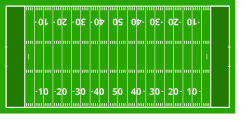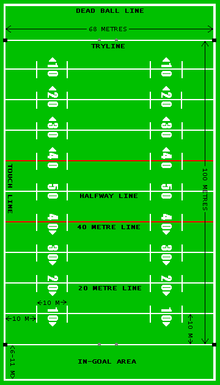British colonists and the British military in Canada brought rugby to North America. It along with association football became popular in American and Canadian universities. At the time soccer and rugby were not as differentiated as they are now and teams would negotiate the rules before playing a game. The sport of American football evolved from these intercollegiate games.
Meanwhile in England a schism developed between those who favoured strict amateurism and those who felt that players should be compensated for time taken off work to play rugby. In 1895 this resulted in the formation of a break-away sport, rugby league, the rules of the two codes of rugby union and league would themselves diverge.
The field


American football is played on a rectangular field 120 yards (110 meters) long by 53 1/3 yards (49 meters) wide. Near each end of the field is a goal line; they are 100 yards apart. A scoring area called an end zone extends 10 yards beyond each goal line. Yard lines cross the field every 5 yards, two rows of hash marks run parallel to the side lines near the middle of the field. At the back of each end zone, there are two goal posts that are 18.5 feet apart (24 feet in high school). The posts are connected by a crossbar 10 feet from the ground.
A rugby league field is very similar, it is 120 metres long and about half that in width, there is a line across the field every ten metres. An in-goal area extends six to twelve meters beyond each goal-line. At the goal line are a set of goal posts in the shape of the letter 'H', used for other forms of point scoring: field goal, penalty goal and conversion.
Possession
In American football, the team that in possession of the ball, the offense, has four downs, to advance the ball 10 yards towards the end zone. When the offense gains 10 yards, it gets another set of four downs. If the offense fails to gain 10 yards after 4 downs, it loses possession of the ball.
This closely resembles the six-tackle rule in rugby league. The team in possession has six tackles before having to hand over possession. The key difference is that there is no automatic way of earning a new set of tackles in rugby league.
In both games, play stops when the player in possession of the ball is tackled and play restarts on the next down / tackle. In both codes, it is normal to advance the ball by carrying it in hand but tactical kicking is an important aspect of play.
Possession may change in different ways in both games:-
- An automatic handover takes place when the team in possession runs out of downs / tackles.
- When the ball is kicked to the opposing team, this can be done at any time but it is normal to punt on the last down / tackle.
- When an opposing player intercepts a pass.
- When the player in possession drops the ball and it is recovered by an opposition player. This is called a fumble in American football.
- In rugby league the opposition are awarded a scrum if the player in possession drops the ball forwards or makes the ball go forwards with any part of his body other than his feet. This is called a knock-on.
- In rugby league if the ball goes out of play, the opposition are awarded a scrum, this is called ball back. Penalties and 40/20 kicks are exceptions to this rule.
- In American football possession changes hands following a succesful score and the team scoring must now kick off to the opposition. In contrast, in rugby league the team who conceeded the score must kick off to the team who scored.
Passing
In American football, the offense can throw the ball forward once on a play from behind the line of scrimmage. The forward pass is a distinguishing feature of American and Canadian football as it is strictly forbidden in rugby league.
The ball can be thrown sideways or backwards without restriction in both games. In American football this is known as a lateral and is much less common than in rugby league.
In both codes, if the ball is caught by an opposition player this results in an interception and possession changes hands.
Tackle
- See also tackle (football move)
In American football, to tackle is to physically interfere with the forward progress of a player in possession of the ball, such that his forward progress ceases and is not resumed, or such that he is caused to touch some part of his body to the ground other than his feet or hands, or such that he is forced to go out of bounds. In any such case, the ball becomes dead, the down is over, and play ceases until the beginning of the next play. A tackle is known as a quarterback sack when the quarterback is tackled behind the line of scrimmage.
In rugby league a tackle is completed when a player's ball-carrying arm touches the ground at the same time as an opponent has some contact with his body, or when one or more opponents hold a player on his feet so that his momentum (in any direction) ceases, or simply if the referee calls held. If necessary, the tackled player is then allowed to his feet; play continues by means of a play-the-ball.
Scoring
A try is the rugby equivalent of a touchdown. Unlike American football, rugby league requires the ball to be grounded, in American football it is sufficient for the player carrying the ball to enter the end zone (in-goal area). In American football a touchdown scores 6 points, in rugby league it is worth 4 points.
In both games, following a try / touchdown, there is the opportunity to score additional points by kicking the ball between the posts and over the bar. In American football this is called an extra point (worth 1 point), in rugby league it is known as a conversion (worth 2 points). There are two key differences between an extra point and a conversion, conversions cannot be charged down like an extra point attempt but they must be taken from the same position as the try was scored. Hence it is important to score under the posts rather than in the corner which makes for a difficult kick.
In American football teams often opt to go for a field goal (worth 3 points) rather than attempt a touchdown. The rugby equivalent is a drop goal worth only one point. The key difference between a field goal and a drop goal is that a field goal attempt is normally kicked with a team-mate holding the ball, whereas in rugby the ball must hit the ground and be kicked from a half-volley.
A similar concept in rugby is the penalty goal. Following the award of the penalty, the attacking team may opt to kick for goal rather than advance the ball by hand or punting. This scores 2 points in league. The penalty goal is similar to a field goal in American football in that the ball is kicked from the ground and may be held by a team-mate, but it cannot be charged. There is no direct equivalent to a penalty goal in American football.
American football has one further method of scoring which does not exist in rugby. If a ball carrier is tackled in their own endzone (in-goal area) with the ball then this results in a safety which scores 2 points. In rugby union this does not score any points but causes the team in possession to kick the ball back to the opposition from under the posts.
Players
- See also American football positions, Rugby league positions
In American football team has 11 players on the field at a time. However, teams may substitute for any or all of their players, if time allows, during the break between plays. As a result, players have very specialized roles, and almost all of the 53 players on an NFL team will play in any given game. Thus, teams are divided into three separate units: the offense, the defense and the special teams.
In rugby the same players have to both defend and attack. There are thirteen players and four replacements in a rugby league team, interchange players can come onto and off the field as long as the maximum number of players is not exceeded. Unlike American football, all players must attack and defend and there is equivalent of special teams.
Broadly speaking offensive and defensive linemen in American football correspond to to forwards in rugby and other players are somewhat similar to backs. However, rugby league players are far less specialised than American footballers.
Many of the positions have similar names but in practice are very different. A fullback in American football is very different from a fullback in rugby, some of the positions are fairly similar; a stand-off carries out a similar role to a quarterback in American football.
See also
- Comparison of Canadian and American football
- Comparison of American football and rugby union
- American football
- Rugby league
- Players who have converted from one football code to another